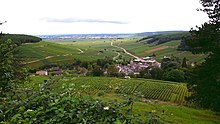Corton (vineyard)
Corton is a Grand Cru classified vineyard on the Côte d'Or in French Burgundy . It is located in the communes of Aloxe-Corton , Pernand-Vergelesses and Ladoix-Serrigny in the Côte de Beaune . Corton has its own appellation . Both red wine (as the only Grand Cru location in the Côte de Beaune) and white wine are produced . Corton occupies the lower elevations of the Montagne de Corton hill of the same name. Due to the size and the different orientation of the vineyards to the sun, the district ( French : Climat ) is often mentioned on the label. The site received AOC status on July 31, 1937. The Corton site shares some parcels with the second Grand Cru site on the hill: Corton-Charlemagne . Both locations together cover an area of almost 160.19 hectares and some of them overlap.
The following rules apply:
- The red wine called Corton may be produced on the entire, defined area (see section Climats). The name of the climat may be mentioned on the label for better definition . Only red wines from the Corton-Charlemagne location are excluded from this rule.
- The white wine called Corton may be produced on the entire, defined area (see section Climats). The name of the climat must not be mentioned. The only exception: the Corton-Vergennes wine from the Hôtel-Dieu de Beaune (Hospices de Beaune).
- Some parcels in Aloxe and Ladoix are allowed to produce red and white wines under the name Corton-Charlemagne.
Corton wines are predominantly red wines (around 95 percent of the AOC) based on the Pinot Noir grape. The small proportion of white wines is made from Chardonnay .
Climate and geology
The Corton is located on a slope at a height of 215 to 350 m above sea level . The forest above protects the location from cold winds. The situation is also mostly spared late frosts. The climate is assigned to the Burgundian transitional climate, in which continental influences predominate over maritime ones. The mostly dry and hot summers allow the Pinot Noir to ripen, but great vintages are only created when there is no rain in autumn to impair the harvest. The Chardonnay still thrives excellently on the plots above.
The bottom of the Corton consists of a thin layer of brown limestone - weathered debris . The vines must drive their roots into the base from the geological age of Bathonium. At a height of 260 m, an approximately 15 m thick layer of Jura rock ( oolite ) is exposed. Geologically it comes from the lower Oxfordium . The upper part has a particularly thin, marl- rich layer.
Wine

The red wines from Corton are usually made exclusively from Pinot Noir . As more varieties are Pinot Liébault and Pinot Beurot approved, are rarely used. Theoretically, up to 15% white grapes ( Chardonnay , Pinot Gris and Pinot Blanc ) can be used; however, this has not been practiced for a long time. The natural alcohol content must be at least 11.5% by volume. The chaptalization is - as everywhere in Burgundy - allowed. The minimum must weight is 189 g / l. The basic yield is 35 hectoliters per hectare, this may be exceeded by a maximum of 20%.
The white wines of the Grand Cru Lage are made from the Chardonnay grape variety. The natural alcohol content of the white wines must be at least 12% by volume, chaptalization is also allowed here. The minimum must weight is 187 g / l. The basic yield is 40 hectoliters per hectare annually . This may be exceeded by a maximum of 20%.
Production quantity
In 2008 a total of 94.78 hectares were declared under the name Corton. Of the total of 2984 hectoliters of wine, 2822 hl were dedicated to red wine and only 162 hl to white wine. This corresponds to a total of almost 400,000 bottles, of which 21,000 bottles are Corton blanc (the white wine).
Manufacturer and owner
In contrast to the Bordeaux wine region , the vineyards are heavily fragmented through the use of inheritance. The largest owner with 15.09 hectares in 2008 was the Louis Latour house. The Hospices de Beaune owned 6.4 hectares through various donations. Domaine d'Ardhuy (4.47 hectares), Comte Senard (3.95 hectares), Prince Florent de Mérode (3.8 hectares), Bouchard Père et Fils followed (3.54 ha), Vincent Sauvestre (3.35 ha), Faiveley (3.02 ha), Maurice Chapuis (2.80 ha), Baron Thénard (2.68 ha, vinified and marketed by Remoissenet Père et Fils) . At least 53 other owners, including Bonneau du Martray , also own shares between 0.11 and 2.57 hectares.
Climats (the districts)
The following climats belong to the Corton appellation and may appear on the label:
In Aloxe-Corton:
|
|
|
In Ladoix-Serrigny:
|
|
|
In Pernand-Vergelesses:
- En Charlemagne (only red wine in plots 409 to 416 and parts of plots 417, 418, 419 and 481)
Source:
Individual evidence
- ↑ Jancis Robinson: The Oxford Wine Lexicon. Hallwag Verlag, Munich 2007, ISBN 978-3-8338-0691-9 , p. 13.
- ↑ BIVB: Les Appellations d'Origine Contrôlée de Bourgogne (PDF; 912 kB), last access on December 28, 2009
- ↑ BIVB: Corton
- ^ Journal officiel de la République Francaise. (PDF; 193 kB)
literature
- Clive Coates : The wines of Burgundy . 1st edition. University of California Press, 2008, ISBN 978-0-520-25050-5 .
- Jancis Robinson : The Oxford Wine Lexicon . 1st edition. Gräfe and Unzer Verlag, 2003, ISBN 3-7742-0914-6 .
- Pierre Galet : Cépages et Vignobles de France . 1st edition. Lavoisier Publishing House, Paris, 2004, ISBN 2-7430-0585-8 .
- Benoît France (ed.): Grand Atlas des Vignobles de France . 1st edition. Solar publishing house, Paris, 2002, ISBN 2-263-03242-8 .


